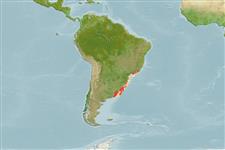>
Clupeiformes (Herrings) >
Alosidae (Shads and Sardines)
Etymology: Brevoortia: From James Carson Brevoort (1818-1887), studie the fauna from Ohio and South Caroline (Ref. 45335).
Eponymy: James Carson Brevoort (1818–1887) was an American collector of coins and rare books. [...] (Ref. 128868), visit book page.
More on authors: Spix & Agassiz.
Environment: milieu / climate zone / Tiefenbereich / distribution range
Ökologie
seewasser pelagic-neritic. Subtropical; 22°S - 38°S, 60°W - 42°W (Ref. 188)
Southwest Atlantic: Rio de Janeiro, Brazil probably to mouth of Rio de la Plata, Argentina (needs confirmation).
Size / Gewicht / Alter
Geschlechtsreife: Lm ? range ? - ? cm
Max length : 34.4 cm TL Männchen/unbestimmt; (Ref. 111977)
Rückenflossenstacheln (insgesamt) : 0; Afterflossenstacheln: 0. Scutes apparent along belly. Upper jaw with distinct median notch. Pectoral fin tip short of pelvic fin base by width of 3 to 7 scales; pelvic fin with oblique and almost straight hind margin. Pre-dorsal scales modified; scales on back and above base of anal fin not markedly smaller than rest. A black spot behind gill opening, but none along flank.
Body shape (shape guide): elongated; Cross section: compressed.
Forms schools (Ref. 188). The morphological characteristics observed and the composition of the trophic spectrum indicate that this species is a filter-feeder, consuming mainly phytoplankton (Ref. 34154).
Life cycle and mating behavior
Geschlechtsreife | Fortpflanzung | Ablaichen | Eier | Fecundity | Larven
Whitehead, P.J.P., 1985. FAO Species Catalogue. Vol. 7. Clupeoid fishes of the world (suborder Clupeoidei). An annotated and illustrated catalogue of the herrings, sardines, pilchards, sprats, shads, anchovies and wolf-herrings. FAO Fish. Synop. 125(7/1):1-303. Rome: FAO. (Ref. 188)
IUCN Rote Liste Status (Ref. 130435: Version 2025-1)
Bedrohung für Menschen
Harmless
Nutzung durch Menschen
Fischereien: kommerziell
Tools
Zusatzinformationen
Download XML
Internet Quellen
Estimates based on models
Preferred temperature (Ref.
123201): 12.6 - 22.8, mean 16.8 °C (based on 104 cells).
Phylogenetic diversity index (Ref.
82804): PD
50 = 0.5156 [Uniqueness, from 0.5 = low to 2.0 = high].
Bayesian length-weight: a=0.00457 (0.00181 - 0.01153), b=3.12 (2.90 - 3.34), in cm total length, based on LWR estimates for this (Sub)family-body shape (Ref.
93245).
Trophic level (Ref.
69278): 2.8 ±0.31 se; based on food items.
Widerstandsfähigkeit (Ref.
120179): hoch, Verdopplung der Population dauert weniger als 15 Monate. (Assuming tm=1).
Fishing Vulnerability (Ref.
59153): Low vulnerability (24 of 100).
🛈
Climate Vulnerability (Ref.
125649): Very high vulnerability (79 of 100).
🛈
Nutrients (Ref.
124155): Calcium = 112 [63, 192] mg/100g; Iron = 1.62 [0.89, 2.74] mg/100g; Protein = 19.5 [18.3, 20.6] %; Omega3 = 0.536 [0.326, 0.892] g/100g; Selenium = 21 [11, 42] μg/100g; VitaminA = 10.8 [3.5, 29.5] μg/100g; Zinc = 0.996 [0.692, 1.440] mg/100g (wet weight);
